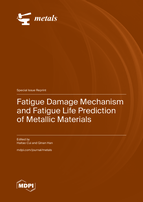Fatigue Damage Mechanism and Fatigue Life Prediction of Metallic Materials
A special issue of Metals (ISSN 2075-4701). This special issue belongs to the section "Metal Failure Analysis".
Deadline for manuscript submissions: closed (30 June 2023) | Viewed by 17758
Special Issue Editors
Interests: fatigue; life prediction; optimal design; nonlinear damage; constitutive relationship; advanced alloys
Special Issue Information
Dear Colleagues,
Metals and alloys are widely used in engineering applications, often requiring careful consideration of complex loading conditions and usually limited by fatigue and fracture performance. The behaviour of metals and alloys under fatigue loading is a multi-scale, complex problem involving microscopic damage initiation, small crack formation, coalescence, propagation and eventually macroscopic fracture failure.
To study the fatigue of metallic materials, experimental, theoretical and numerical methods need to be developed. Novel testing and characterization techniques such as in situ observation, non-contact measurement and microscopic characterization provide insights into the fatigue process and damage mechanisms. Techniques for testing advanced fatigue life facilitate the generation of fatigue performance data. Fatigue and fracture theory, cyclic constitutive relationships, numerical simulations or data-driven methods enable the creation of accurate fatigue life prediction models, as well as optimal design for improved fatigue life.
In addition, fatigue is also affected by many factors, such as extreme conditions that involve multi-axis stress, high strain rates, and ultra-high/low temperatures, combined loads that involve thermal, mechanical and irradiation loadings, microstructure heterogeneities such as defects, texture, crystal orientation, and grain morphology, to name a few. It is important to investigate metal fatigue under these conditions. With the development of novel techniques for manufacturing metallic materials, the relationship between processing, structure and fatigue property has also become an important topic.
This Special Issue aims to present recent research advancements regarding the fatigue of metallic materials. Potential topics may cover, but are not limited to, experimental testing, characterization, theory development and modelling of the fatigue behaviour of various metallic materials over different scales, with one or multiple physical processes. We also encourage the submission of research articles that integrate experimental or situational data with data-driven algorithms into the analysis of fatigue performance.
Prof. Dr. Haitao Cui
Dr. Qinan Han
Guest Editors
Manuscript Submission Information
Manuscripts should be submitted online at www.mdpi.com by registering and logging in to this website. Once you are registered, click here to go to the submission form. Manuscripts can be submitted until the deadline. All submissions that pass pre-check are peer-reviewed. Accepted papers will be published continuously in the journal (as soon as accepted) and will be listed together on the special issue website. Research articles, review articles as well as short communications are invited. For planned papers, a title and short abstract (about 100 words) can be sent to the Editorial Office for announcement on this website.
Submitted manuscripts should not have been published previously, nor be under consideration for publication elsewhere (except conference proceedings papers). All manuscripts are thoroughly refereed through a single-blind peer-review process. A guide for authors and other relevant information for submission of manuscripts is available on the Instructions for Authors page. Metals is an international peer-reviewed open access monthly journal published by MDPI.
Please visit the Instructions for Authors page before submitting a manuscript. The Article Processing Charge (APC) for publication in this open access journal is 2600 CHF (Swiss Francs). Submitted papers should be well formatted and use good English. Authors may use MDPI's English editing service prior to publication or during author revisions.
Keywords
- fatigue
- life prediction
- damage mechanism
- failure analysis
- numerical simulation
- cyclic constitutive relationship
- optimal design
- fatigue characterization
- extreme conditions
- crack behavior
- data-driven method







